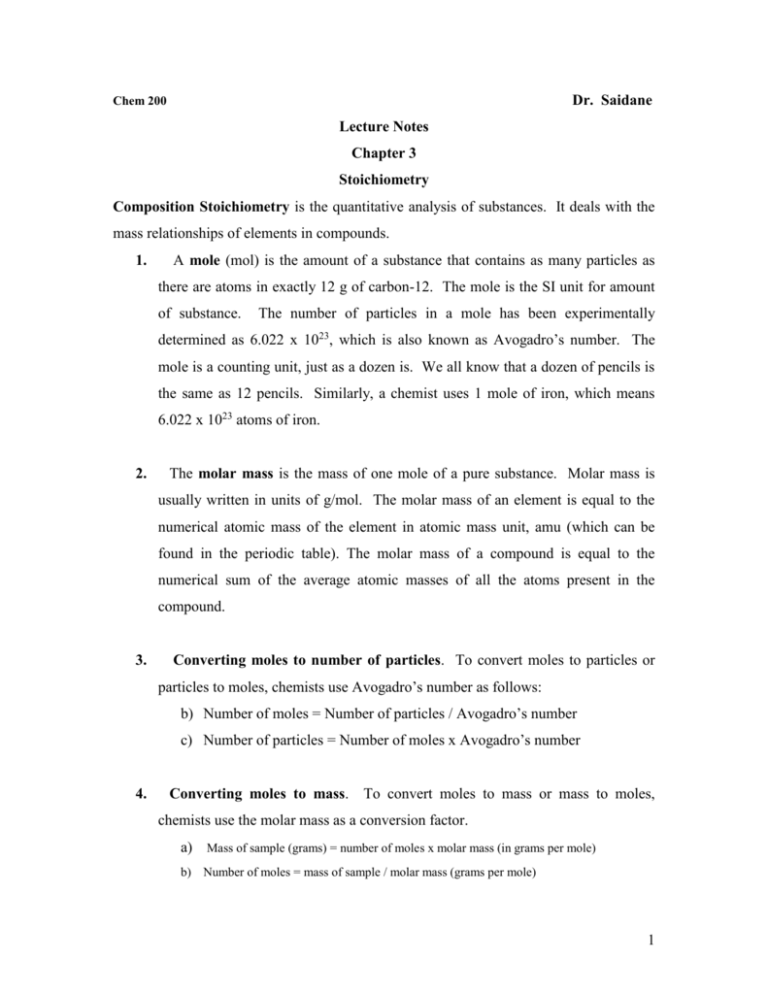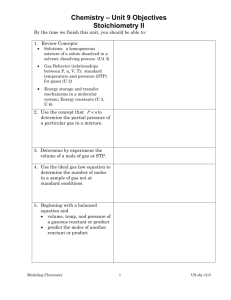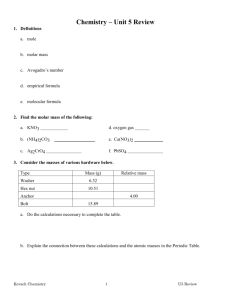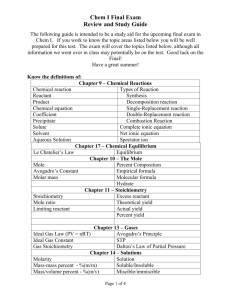Chem 200 Dr. Saidane
advertisement

Dr. Saidane Chem 200 Lecture Notes Chapter 3 Stoichiometry Composition Stoichiometry is the quantitative analysis of substances. It deals with the mass relationships of elements in compounds. 1. A mole (mol) is the amount of a substance that contains as many particles as there are atoms in exactly 12 g of carbon-12. The mole is the SI unit for amount of substance. The number of particles in a mole has been experimentally determined as 6.022 x 1023, which is also known as Avogadro’s number. The mole is a counting unit, just as a dozen is. We all know that a dozen of pencils is the same as 12 pencils. Similarly, a chemist uses 1 mole of iron, which means 6.022 x 1023 atoms of iron. 2. The molar mass is the mass of one mole of a pure substance. Molar mass is usually written in units of g/mol. The molar mass of an element is equal to the numerical atomic mass of the element in atomic mass unit, amu (which can be found in the periodic table). The molar mass of a compound is equal to the numerical sum of the average atomic masses of all the atoms present in the compound. 3. Converting moles to number of particles. To convert moles to particles or particles to moles, chemists use Avogadro’s number as follows: b) Number of moles = Number of particles / Avogadro’s number c) Number of particles = Number of moles x Avogadro’s number 4. Converting moles to mass. To convert moles to mass or mass to moles, chemists use the molar mass as a conversion factor. a) Mass of sample (grams) = number of moles x molar mass (in grams per mole) b) Number of moles = mass of sample / molar mass (grams per mole) 1 5. Determination of chemical formulas b) Mass percentage composition. The percentage by mass of each element in a compound is known as the percentage composition of the compound. Mass percentage of element = (mass of element in sample/total mass of sample) x 100% c) Empirical formulas. An empirical formula consists of the symbols for the elements combined in a compound, with subscripts showing the smallest wholenumber mole ratio of the different atoms in the compound. The following steps are used to determine the empirical formula: 6. First convert the percentage composition to a mass composition. If a compound is 78% B and 22% H, we can assume that 100 g of the compound is made of 78 g of B and 22 g of H. i. Next, convert the mass composition of each element to a mole composition by dividing by the appropriate molar mass. 78 g B x 1 mol B/10.81 g B = 7.22 mol B 22 g H x 1 mol H/1.01 g H = 21.7 mol H. iii) Find a mole ratio by dividing each number of moles by the smallest number in the existing ration. 7.22 mol B / 7.22 = 1 mol B 21.7 mol H / 7.22 = 3.01 ~ 3 mol H. The empirical formula is BH3 The mole ratio must be close to a whole number. If one of the mole ratios is not a whole number, then multiply them by the same integer until they all are whole numbers. c) The molecular formula of a molecular compound is the real formula of the compound and is a multiple of the empirical formula. The relationship between a compound’s empirical formula and its molecular formula can be written as follows: n x empirical formula = molecular formula, with n an integer. Reaction Stoichiometry How much starting material must be used to obtain a specific amount of product? How much products will be formed from specific amounts of starting material (reactants)? 2 Stoichiometry is used to interpret a reaction quantitatively. It involves the mass relationship between reactants and products in a chemical reaction. All reaction- stoichiometry calculations start with a balanced chemical equation. This equation gives the relative number of moles of reactants and products. Solving reaction-stoichiometry problems requires the use of a mole ratio to convert from moles of a substance A to moles of a substance B in the chemical reaction. A mole ratio is a conversion factor that relates the amounts in moles of any two substances involved in a chemical reaction. There are different types of reaction-stoichiometry problem that can be classified according to the given and to the unknown. 7. Mole-to-Mole Calculations. The known is moles of A and the unknown is moles of B: Moles of B = Given moles of A x (moles of B/moles of A), with (moles of B/moles of A), the molar ratio from balanced equation. 8. Mass-to-Moles Calculations. The known is the mass of A and the unknown is the mole of B. * Convert mass of A to moles of A using the molar mass of A. * Convert moles of A to moles of B using the molar ratio from the chemical equation. 9. Mass-to-Mass Calculations. The known is Mass of A and the unknown is the mass of B. In this case, follow the following steps: b) Convert mass of A to moles of A using the molar mass. c) Convert moles of A to moles of B using the molar ratio from the equation. d) Convert moles of B to mass of B using the molar mass of B. Limiting Reactant. In the laboratory, reactions are rarely carried out with exactly the required amount of each of the reactants. In most cases, one of the reactant is present in excess; that is there is more than the exact amount required to react. The limiting reactant is the reactant that limits the amounts of the other reactants that can combine and the amounts of product that can form in a chemical reaction. In order to determine the limiting reactant, the given amount of either reactant is used to calculate the required amount of the other reactant. The calculated amount is then compared with the amount actually available. 3 Percent Yield. The theoretical yield of a product is the maximum amount of product that can be produced from a given amount of reactant. In most chemical reactions, the measured amount of a product obtained from a reaction is less than the theoretical yield, and is called the actual yield. The percent yield is the ratio of the actual yield to the theoretical yield, multiplied by 100. Percent yield = (actual yield / theoretical yield) x 100 If a reactant takes part of only one reaction, then the yield of the product would be 100% because no competing reactions are taking place. However, if a reactant can take part in more than one reaction at the same time, then the yield of a particular product will be less than 100% because other products will also form. Combustion Analysis Combustion analysis is a technique based on the concept of limiting reactants. It is widely used for the determination of the empirical formulas of organic compounds containing carbon, hydrogen, and oxygen and involves determining the masses of water and carbon dioxide that are formed when an organic compound-the limiting reactant- is burned in a plentiful supply of oxygen. The number of moles of C, H, and O atoms in a sample are determined from the masses of carbon dioxide and water produced. Skills you should have mastered Conceptual 1. Give the definition of a mole. 2. Explain the significance of the stoichiometric coefficients in a chemical equation. 3. Explain what is meant by a mole ratio and state how it is used. Problem-solving 1. Use the Avogadro constant to convert between number of moles and the number of atoms, molecules, or ions in a sample. 2. Calculate the average molar mass of an element, an ion, or a compound. 3. Convert between mass and number of moles by using the molar mass. 4 4. Calculate the empirical formula of a compound from its mass percentage composition. 5. Determine the molecular formula of a compound from its empirical formula and its molar mass. 6. Carry out mole-to-mole, mass-to-mole, and mass-to-mass calculations for any two species involved in a chemical reaction. 7. Calculate the theoretical and percentage yields of the products of a reaction, given the mass of starting material. 8. Identify the limiting reactant of a reaction and calculate the amount of excess reactant present, given the initial mass of each reactant. 9. Use the limiting reactant to calculate the yield of a product. 10. Determine the empirical formula of an organic compound by combustion analysis. Descriptive Describe how a combustion analysis is conducted and interpreted. 5







